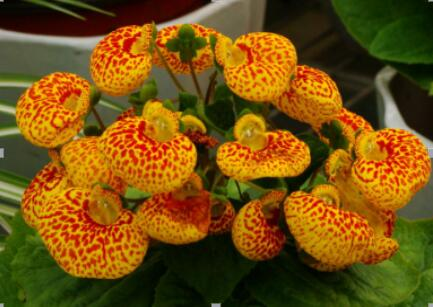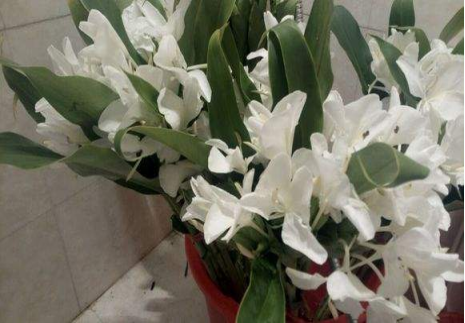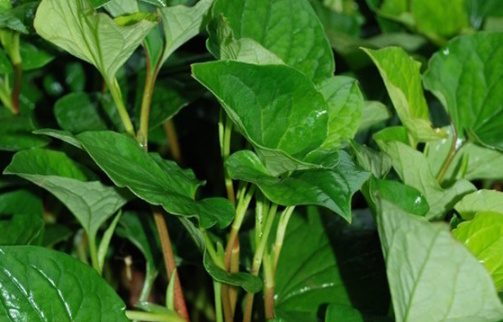Family Culture method of Baobao Flower
First, sowing time
The seeds of Baobao flower are small, about 25000 seeds per gram, and the optimum temperature for germination is 18-21 ℃. Therefore, when the weather turns cool after high temperature, that is, from late August to early September, early sowing temperature is high, seedlings are prone to quenching disease and rot disease, too late sowing will affect flowering.
2. Sowing method
The soil for pot sowing should be sterilized at high temperature. When sowing, the soil should be pressed, the seeds should be gently sowed and pressed flat, because the seeds are small, the sowing should not be too dense, the covering of soil should not be too thick (even not covered with soil), the bottom of the pot should be covered with glass or film, put in a semi-shaded place, the room temperature should be maintained at about 20 ℃, and germinate 7 days after sowing. When the seedlings grow to 2-3 leaves, interplant or move the seedlings in time, and pay attention to ventilation and maintain humidity. The room temperature is controlled at about 15 ℃.
3. Methods of transplanting seedlings
When the seedling has 2-3 true leaves, it can be transplanted, and when it grows 4-6 true leaves, it can be put on the pot. 30 days after seedling transfer, the seedling was planted in a pot of 10 cm to 15 cm when the seedling height was 5 cm. The best room temperature is 10-12 ℃.
The culture soil was mixed with 2 parts of rotten leaf soil, 1 part of barnyard manure, 1 part of sand and 6 parts of garden soil, and the pH value was 6.5.

The Flower language of Pu Baobao Flower and the Legend of Orange Pu Bao Hua
Flower language: a symbol of wealth and assistance
Legend: once upon a time, there was an old village that had been dry for a long time, and the crops in the fields were almost withered. When the village head's daughter knew about this, she washed her face with tears at home every day. One day, her tears inadvertently fell on a genie, who asked her why she was crying. So she told the cause of the matter. After hearing this, the elf asked her if she was willing to sacrifice herself for everyone, and the little girl agreed without hesitation, so the elf turned her into an orange bushbag flower on the edge of the well. By the next day, the dry well was full of water, and the villagers used it to save the crops. From then on, the village became favorable and abundant.
Baipu Baobao flower
Flower language: a symbol of loss
Legend: a long time ago, there was a poor scholar who studied hard every day, hoping that one day he could be admitted to fame to change his life. However, sadly, he failed the list every time, slowly became more and more disappointed, fell ill, and soon died. After that, an unknown flower appeared on top of his grave, and the white flower exuded a faint fragrance.
Purple bungee flower
Flower words: a symbol of parting
Legend: a long time ago, a princess fell in love with a very brave soldier on the hunting ground. At the end of the hunt, the princess met the soldier. After that, the two fell in love. However, the two were not together for a long time, and the soldier was sent to the battlefield. at parting, the soldier picked a purple flower on the side of the road and planted it on the princess's head. After kissing the princess's tearful face, he rode off to the battlefield.
How's it going? Having seen the above family culture methods, have the friends raised beautiful bungee flowers at home? If you also like bushy flowers, then follow our four Seasons Plant Network! Here are more information waiting for you!
Family Flower Culture Indoor Flower Culture method
How to raise indoor flowers? How can we raise indoor flowers well? Take a look at the following introductions to indoor flower farming methods:
I. methods of indoor flower culture in families
According to experts, in order to make indoor flowers grow well, we must master the ecological habits of flowers, and master the light, water, fertilizer, temperature, humidity, and pest control needed for family flower growth. Here are some suggestions from experts:
Most families can't reach the humidity of the greenhouse, while most native tropical plants prefer a humid environment. In the greenhouse, flowers can receive sunlight through the shade net all day, so that they do not accept direct sunlight, while in the home, there is often insufficient light, or sunlight exposure. Many flowers like the semi-overcast environment, but the sun is too weak in winter, so flowers can fully accept the sun. The suitable growth temperature of most flowers is between 15 ℃ and 20 ℃. If the temperature is too high, the flowers bloom quickly and it is easy to cause problems.
Regular fertilization and moderate watering are carried out in greenhouses, and compound fertilizers suitable for all growth stages are needed, while in families, flowers are often burned out due to lack of horticultural knowledge, or malnutrition caused by non-fertilization, or excessive fertilization at one time. In particular, it should be noted that no fertilization or a small amount of compound fertilizer can be applied at flowering stage, and "hypertrophy" is disadvantageous to flowering.
Flowers like neutral or acid soil, if the tap water is alkaline, long-term watering will make the soil alkali, but also affect the quality of flowers. If the viscous weight of the soil is impervious, it will also affect the respiration of the roots, and even rot the roots. Basically master watering to see wet and dry, small evaporation in winter, do not water too often, too much water is easy to rot roots, before watering, you must use your hands to touch the basin soil, so you can grasp the degree of dryness and wetness of the soil and avoid blind watering.
Most flowers like the environment with high air humidity, so spray more water around the flowers in order to increase the air humidity. Try to keep flowers in sunny and well-ventilated places, so as to avoid the occurrence of diseases and insect pests. The temperature of the room had better not be lower than 5 ℃, nor more than 25 ℃. Large water, low air humidity and high temperature are often the main factors causing problems with flowers.
In addition, farmed flowers should also pay attention to the following aspects:
1. The air is dry. When the indoor air is too dry, flowers often appear leaf tip dryness or leaf edge scorching and other phenomena. Attention should be paid to water spraying, plastic film cover and other methods to increase air humidity.
2. Excessive fertilization. If you fertilize too much, the new leaves will be thick, and the old leaves will be rugged, and the dry tips of the old leaves will fall off. You should immediately stop fertilization, increase the amount of water exchange, make the fertilizer lose, or immediately pour the pot, rinse the bulb root with water and then plant it again into the basin.
3. Hot and hot. If the flowers are placed in a high temperature place to let the strong light shine directly, it is very easy to cause the young leaf tip and leaf edge to scorch, or the leaf yellow to fall off. Move to a well-ventilated shady place in time.
4. Excessive shade. If the flowers are kept in shade or in a place with insufficient light for a long time, it will cause the branches and leaves to turn yellow.
5. whether it is airtight or not. If too much nitrogen fertilizer is applied, the branches and leaves will grow luxuriantly, coupled with the long-term unpruned, resulting in insufficient light in the inner chamber branches and leaves, which is easy to cause the leaves to yellowing and falling off. Reasonable fertilization should be applied and pruning should be strengthened to make it ventilated and transparent.
2. A collection of pictures of indoor flowers
Bulb flowers: such as daffodils, daffodils, tulips, hyacinths all belong to seasonal flowers, the flowering period is very short, generally only 1 week to 2 weeks, in the room can be put in sufficient sunshine, low temperature, the temperature is too high, so that the flowers bloom quickly and shorten the florescence.
Orchid flowers: such as Cymbidium, Cymbidium, Phalaenopsis, Cartland, Dendrobium grow under tropical trees in nature, like dampness and shade, avoid direct sunlight, and grow well in bright semi-shade. Therefore, more water should be sprayed in the family to increase air humidity. It can be exposed to soft sunlight in winter so that it can carry out photosynthesis and increase nutrition. Orchid flowers are easily affected by snails and scale insects, which can be dropped with toothbrushes. Take the common orchid as an example, it is native to the forests of subtropical South Africa, where the four seasons are as warm as spring, with an average temperature of no less than 10 ℃ and a maximum temperature of no more than 22 ℃. The gentleman orchid likes the soft light, avoid the scorching sun exposure, the gentleman orchid is the fleshy root, has the certain drought resistance ability, the watering is too big, will cause the root system to rot. The water content of the magnolia basin soil should be squeezed into a ball with the hand, and it is appropriate to press it gently and loosely.
Amorphophallus and ferns: taro plants such as peacock taro, purple-backed taro, ferns such as Boston fern, like semi-shady, warm, high humidity and well-drained environment, bright light, not resistant to direct sunlight.
Calla lilies: good light, good water, good fertilizer, like moist soil, high air humidity.
Flamingo: also known as Anthurium andraeanum, it likes the environment of damp, warm and unobstructed drainage. Shell insects are common insect pests. Pay attention to prevention and control, just use a brush.
Melon leaf chrysanthemum: like the sun, like wet, like fertilizer, but flowering should reduce fertilization, watering should be appropriate to dry or too wet, low temperature should be controlled watering, slightly moist, should pay attention to ventilation, otherwise, melon leaf chrysanthemum is easy to suffer from powdery mildew or be harmed by aphids and red spiders.
Big rock tree: like warm and humid, good fat, avoid direct sunlight. Cyclamen prefers sunny, cool and humid climate. 10 ℃ to 20 ℃ is the suitable growth temperature, afraid of high temperature.
Belgian rhododendron: sexual preference for cold, moist, acidic humus soil.
Crab claw orchid: like warm, moist, semi-shady environment. The suitable temperature for growth is from 15 ℃ to 20 ℃, and when the temperature is lower than 5 ℃, it goes into dormancy.
Pu Baobao flower: like warm, cool, moist and well-ventilated environment, not cold-resistant, avoid dampness.
Rieger Begonia: like warm, humid environment, semi-overcast environment.
Poinsettia: like adequate light, require good drainage, good ventilation of loose and fertile soil, strict moisture requirements, excessive soil moisture will often cause root disease, and then lead to fallen leaves; insufficient soil moisture, poor plant growth, but also fallen leaves.
Kumquat: like warm and humid, adequate light, suitable for fertile, good drainage, good ventilation of sandy soil, not cold, avoid drought.
Ornamental pineapple: like high temperature, humid, semi-shady environment. The sandy soil containing humus should be used in potted soil, and the overwintering temperature should be above 10 ℃.
Summary: a large number of pictures of indoor flowers, people have to take action after seeing. Action is better than action. According to the method of family flower culture introduced by the editor, let's decorate the loving home together.
- Prev

Cultivation method of Ginger Flower in Pot
1. Temperature ginger flower is a kind of subtropical plant, which likes high temperature and high humidity, so pot planting requires higher temperature. Generally speaking, the indoor temperature is above 10 degrees Celsius in winter. 2. Soil ginger flowers like water, but they should also have a soil with good drainage, otherwise they are easy to rot.
- Next

How to raise Houttuynia cordata
First, the light Houttuynia is more afraid of the sun, especially when the light is fierce. If the plant is raised on a sunny balcony, shade it for healthy growth, or place the plant on a shady or less light side. Second, although the temperature is more resistant to shade
Related
- Fuxing push coffee new agricultural production and marketing class: lack of small-scale processing plants
- Jujube rice field leisure farm deep ploughing Yilan for five years to create a space for organic food and play
- Nongyu Farm-A trial of organic papaya for brave women with advanced technology
- Four points for attention in the prevention and control of diseases and insect pests of edible fungi
- How to add nutrient solution to Edible Fungi
- Is there any good way to control edible fungus mites?
- Open Inoculation Technology of Edible Fungi
- Is there any clever way to use fertilizer for edible fungus in winter?
- What agents are used to kill the pathogens of edible fungi in the mushroom shed?
- Rapid drying of Edible Fungi

